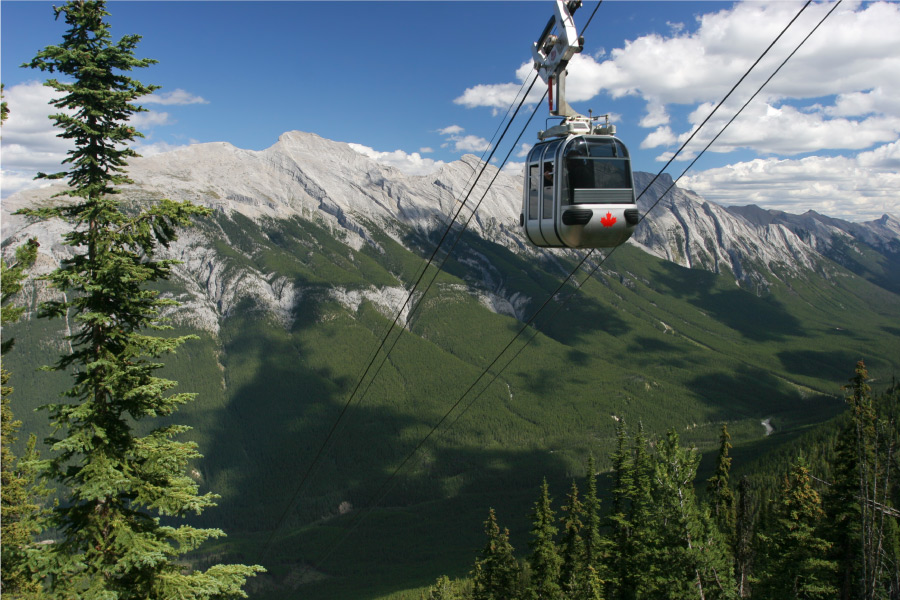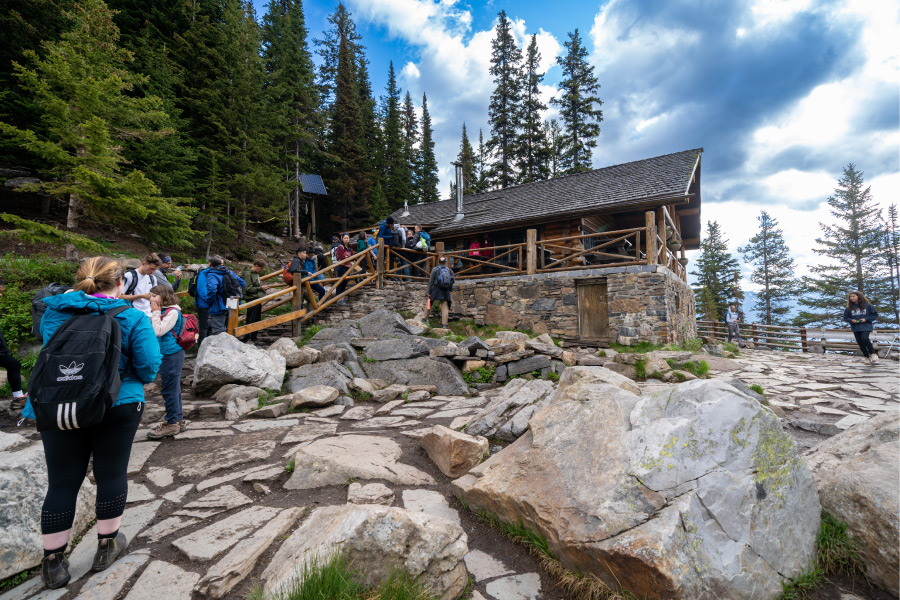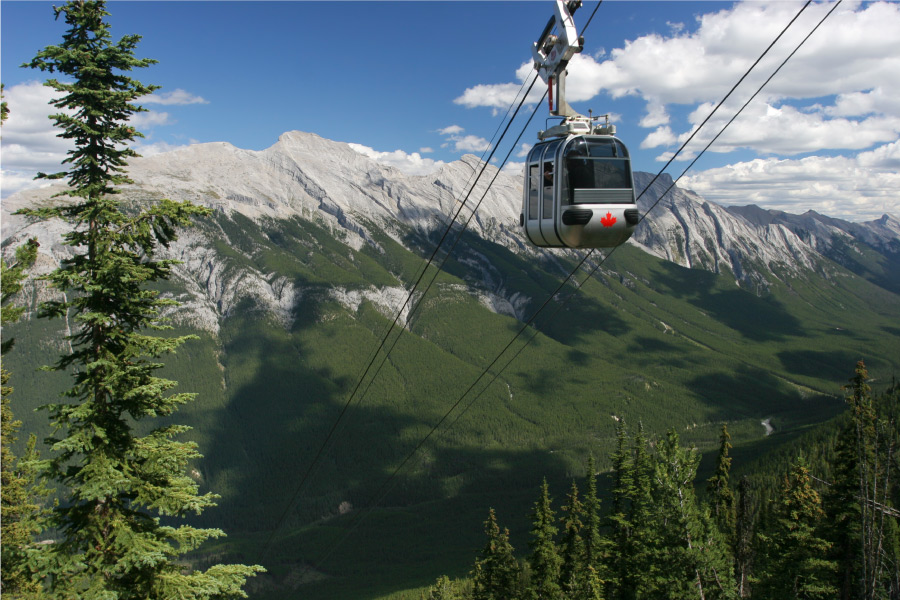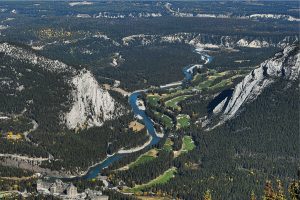
History of the Park
The history of Banff National Park is a fascinating journey that spans thousands of years, from the early Indigenous presence in the region to the establishment of a national park in the late 19th century.
Long before Europeans arrived in North America, Indigenous peoples inhabited the area that is now Banff National Park. The Stoney Nakoda, Ktunaxa, Tsuut’ina, Kainai, Piikani, and Siksika nations all had connections to this land, relying on its abundant resources and using the region as a meeting and trading place. These Indigenous communities respected and revered the land, and their presence in the area can be traced back more than 10,000 years.
The first Europeans to venture into the region were fur traders and explorers in the late 1700s and early 1800s. Among the most notable were David Thompson, a British-Canadian fur trader, and explorer who crossed the Canadian Rockies and established the first trading post in the region. However, it wasn’t until the construction of the Canadian Pacific Railway (CPR) in the 1880s that Banff’s destiny as a national park was set in motion.
In 1883, three railway workers – Tom McCardell, William McCardell, and Frank McCabe – stumbled upon a series of hot springs on the slopes of what is now known as Sulphur Mountain. Recognizing the potential for these hot springs as a tourist attraction, the Canadian government set aside a 26-square-kilometer (10-square-mile) reserve around the hot springs in 1885. This marked the birth of Banff National Park, initially known as the “Banff Hot Springs Reserve.”
With the establishment of the reserve, the Canadian government and the CPR saw an opportunity to promote tourism in the region. The CPR built the Banff Springs Hotel, a luxurious resort that opened its doors in 1888, attracting wealthy tourists from around the world. The hotel’s success, coupled with the expanding railway network, helped to bring increasing numbers of visitors to the area.
In 1902, the reserve was expanded and renamed “Rocky Mountains Park,” before finally becoming Banff National Park in 1930, when the National Parks Act was passed. This act aimed to protect Canada’s natural heritage and preserve the park for the enjoyment of future generations.
Throughout the 20th century, Banff National Park continued to evolve and expand, with the development of new facilities, roads, and trails, as well as the establishment of the park’s boundaries. Conservation efforts have been a top priority, with the reintroduction of species such as bison and ongoing initiatives to protect the park’s flora and fauna.
Today, Banff National Park is a UNESCO World Heritage Site, encompassing an area of over 6,641 square kilometers (2,564 square miles) and drawing millions of visitors each year. The park is a testament to the vision of those who recognized the importance of preserving Canada’s natural beauty and serves as a reminder of our responsibility to protect these lands for future generations.
As you immerse yourself in the captivating history of Banff National Park, it is hard not to feel a deep connection to this extraordinary place. The stories of Indigenous communities, explorers, and visionaries who have shaped the park’s history are a testament to the enduring allure and significance of this spectacular landscape. The preservation and celebration of Banff National Park’s history help us understand the importance of our shared natural heritage and our responsibility to care for it.
The breathtaking beauty and rich history of Banff National Park serve as a constant reminder of the power of nature and the impact it has on our lives. From the Indigenous peoples who first walked these lands to the modern-day visitors who come from around the world to experience its wonders, Banff has always been a place that transcends time and space. It is a living testament to our connection to the natural world and our shared commitment to its preservation.
As you explore Banff National Park’s striking landscapes and delve into its fascinating past, you will undoubtedly feel an emotional bond with this extraordinary place. The park’s history is a captivating tale of human endeavor, natural wonder, and the enduring power of our collective passion for preserving the environment. By understanding and appreciating Banff’s history, we can forge a deeper connection with the park and work together to ensure its legacy is preserved for generations to come.
So, as you embark on your journey through Banff National Park, take a moment to pause and reflect on the park’s remarkable past. Embrace the sense of awe and wonder that has captivated generations before you and let the spirit of Banff’s history guide you on your adventure. In doing so, you will not only forge a lasting connection with this extraordinary place but also become part of the ongoing story of Banff National Park – a story that continues to unfold with each passing day.
Let the history of Banff National Park serve as an inspiration and a reminder of our responsibility to protect and preserve these unique and treasured landscapes. Through understanding and appreciation, we can ensure that the story of Banff continues to be told and that its natural beauty and cultural significance remain a source of inspiration and connection for generations to come.
Natural Features
Banff National Park showcases an astonishing variety of natural features, from towering mountain peaks to turquoise alpine lakes and lush forests. The park is situated in the Canadian Rockies, a magnificent mountain range that stretches over 1,000 kilometers (620 miles) and forms a part of the North American Continental Divide. These rugged mountains are composed primarily of sedimentary rock, shaped over millions of years by geological forces such as glaciation, erosion, and tectonic activity.
One of the most iconic natural features of Banff National Park is its pristine alpine lakes, renowned for their vivid turquoise hues. These striking colors are a result of rock flour, fine particles of rock ground down by glaciers, which scatter sunlight and create the lakes’ signature appearance. Among the park’s most famous lakes are Lake Louise, Moraine Lake, and Peyto Lake, each offering breathtaking vistas and endless opportunities for exploration.
In addition to its spectacular lakes, Banff National Park is home to vast expanses of forest, primarily consisting of spruce, fir, and pine trees. These lush forests provide vital habitat for a diverse array of flora and fauna, including more than 1,000 species of plants and a wide range of wildlife, such as elk, deer, bighorn sheep, mountain goats, and bears.
Glaciers are another key natural feature of the park, with the Columbia Icefield being the most notable example. This vast icefield feeds several major glaciers, including the Athabasca Glacier, which is one of the most accessible and visited glaciers in North America.
Recreational Activities
Banff National Park offers an abundance of recreational activities that cater to a variety of interests and skill levels. The park’s extensive trail network provides countless opportunities for hiking and mountain biking, with trails ranging from leisurely strolls to challenging backcountry expeditions. Some popular hiking destinations include Johnston Canyon, Lake Agnes Tea House, and the Plain of Six Glaciers.
During the winter months, Banff transforms into a snowy paradise, with world-class skiing and snowboarding available at three major ski resorts: Sunshine Village, Lake Louise Ski Resort, and Mt. Norquay. The park also offers a range of other winter activities, such as cross-country skiing, snowshoeing, ice skating, and even ice climbing for the more adventurous.
Water-based activities are also popular in the park, with canoeing, kayaking, and stand-up paddleboarding available on many of its picturesque lakes. For those seeking a more thrilling experience, the park’s rivers provide ample opportunities for whitewater rafting and river floating.
Finally, wildlife enthusiasts will delight in the chance to observe the park’s abundant fauna. Guided wildlife tours and interpretive programs are available to help visitors learn about the park’s diverse species and the importance of conservation efforts.
Cultural Significance
Banff National Park holds a deep cultural significance, with a history that extends far beyond its establishment as a protected area. As previously mentioned, the Indigenous peoples of the Stoney Nakoda, Ktunaxa, Tsuut’ina, Kainai, Piikani, and Siksika nations have long-standing connections to the land that is now the park. These communities have used the region for hunting, gathering, and spiritual practices for thousands of years, and their stories and traditions continue to be an important part of the park’s cultural fabric.
In more recent times, Banff National Park has played a significant role in the development of Canada’s national park system and the conservation movement. The park’s establishment in 1885 marked the beginning of a nationwide commitment to preserving the country’s natural heritage, and its ongoing efforts to protect and restore its ecosystems serve as a model for other protected areas around the world. Banff National Park’s status as a UNESCO World Heritage Site further highlights its global cultural and environmental significance.
The park’s cultural importance is also reflected in its historical sites and structures, many of which have been preserved for visitors to explore. The Banff Springs Hotel, for example, stands as an architectural marvel and a testament to the early days of tourism in the region. Similarly, the Cave and Basin National Historic Site, where the park’s founding hot springs were discovered, offers a glimpse into the origins of Banff National Park and the role it played in shaping Canada’s identity.
Moreover, the park has long been a source of artistic inspiration, attracting painters, photographers, and writers who have been captivated by its breathtaking beauty. The works of these artists, along with the stories of early explorers and mountaineers, have contributed to the enduring allure of Banff National Park and helped shape the cultural narrative surrounding this remarkable landscape.
As a melting pot of history, art, and Indigenous heritage, Banff National Park holds a unique and profound cultural significance. Its diverse array of natural features and recreational activities make it an ideal destination for visitors seeking to immerse themselves in the beauty and spirit of the Canadian Rockies. By understanding and appreciating the park’s cultural importance, we can forge a deeper connection to this extraordinary place and ensure its legacy is preserved for future generations.
Challenges and Future of the Park
Banff National Park, like many protected areas worldwide, faces a unique set of challenges as it navigates the complexities of balancing conservation, tourism, and cultural preservation. In this section, we will explore some of the pressing issues that the park confronts and discuss potential strategies for addressing these challenges to ensure a sustainable and vibrant future.
One of the most significant challenges facing Banff National Park is the increasing number of visitors it receives each year. While tourism is essential for the local economy and serves to foster appreciation for the park’s natural and cultural wonders, the sheer volume of visitors puts immense pressure on the park’s infrastructure, resources, and ecosystems. The resulting environmental impacts, such as soil erosion, habitat fragmentation, and increased human-wildlife conflicts, pose a considerable threat to the park’s long-term health and viability.
To address this issue, park management has begun implementing measures to manage visitor flow and minimize the impact of tourism on the park’s ecosystems. These strategies include promoting responsible visitor behavior, implementing seasonal restrictions on certain activities, and developing sustainable transportation options to reduce congestion and emissions within the park. Additionally, park management is exploring opportunities for collaboration with Indigenous communities, whose traditional knowledge and stewardship practices can provide valuable insights into sustainable land management.
Climate change is another major challenge facing Banff National Park, as rising temperatures and shifting weather patterns have far-reaching consequences for the park’s ecosystems. Glaciers within the park are retreating at an alarming rate, resulting in reduced water availability for downstream ecosystems and impacting the habitats of numerous species. Moreover, warmer temperatures are facilitating the spread of invasive species and diseases, posing a further threat to the park’s biodiversity.
To combat the effects of climate change, Banff National Park is working to develop and implement adaptive management strategies that prioritize ecosystem resilience and biodiversity conservation. This involves conducting ongoing research and monitoring programs to better understand the impacts of climate change on the park’s ecosystems and using this information to inform management decisions.
Finally, fostering meaningful relationships with Indigenous communities is a critical aspect of the park’s future. Acknowledging and respecting the cultural significance of the park for Indigenous peoples is vital for ensuring that their voices are heard and that their rights and interests are considered in the park’s management. Collaborative efforts between the park and Indigenous communities can lead to more equitable and sustainable management practices, ultimately benefiting both the park’s ecosystems and the people who depend on them.
The future of Banff National Park is intricately tied to our ability to address these challenges and embrace innovative, collaborative approaches to conservation and management. By recognizing the importance of balancing tourism, conservation, and cultural preservation, we can work together to ensure that Banff National Park remains a cherished and protected landscape for generations to come.




